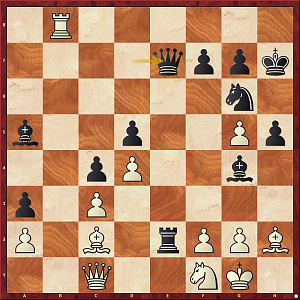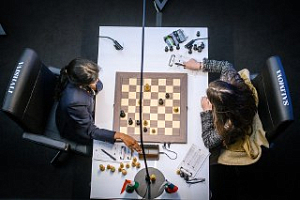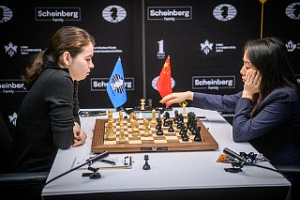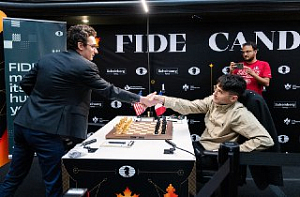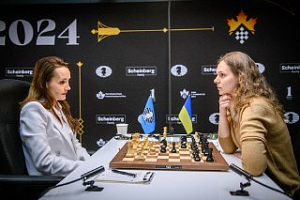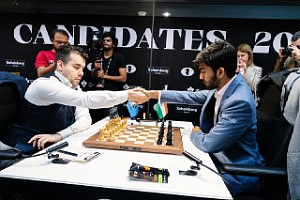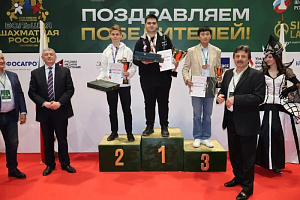Vis-a-vis with a Jacket
Vladimir Barsky reports from Berlin about round two of the Candidates Tournament
– I have all the pieces in the attack, and Black defends with one bishop. If there is no mate, I just quit chess! - declared Alexander Grischuk at a press conference after the game with Wesley So. To the delight of the numerous Moscow fans, Black’s position was hopeless indeed. The American grandmaster was not checkmated, but saving his king required his giving up a piece, which was equivalent to a defeat. However, Grischuk's conversion tickled the audience’s nerves as he was down to only 10-15 seconds per move more than once.
– Of course, I was nervous in time trouble, - shared his emotions Alexander. – It is a normal state for a chess player, it cannot be otherwise. For example, yesterday I was not nervous at all.
Grischuk did not finish his thought, but the audience understood him without his having to say anything: in round one he suffered a bitter defeat from the former world champion Vladimir Kramnik. The failure has obviously put Alexander on his mettle, and he went on to immediately take a convincing revenge. It's amazing how quickly a calm line of the Ruy Lopez transposed into a hopeless position for Black.
– Black’s 12th move looks risky, of course, but it gave Black a normal position, in my opinion, and I failed to discover any "deadly" combination for White, - noted Grischuk in the post mortem. "However, Wesley’s followup was underwhelming; I think it was either his 17th or 18th moves that are to blame. Who knows! Honestly, I was surprised to find out how bad things were for Black at that stage already. When all opponent's pieces bear down on your king, you have to be very precise in your performance. When my rook landed on g4, I no longer saw any good continuations for Black. He only had one bishop defending his king.
The Russian threw his entire army against a lone bishop of Wesley’s, including both rooks: one arrived at the royal flank along the fourth rank, while the second one was about to join via the fifth. The American tried to muddy the waters by giving up a piece for a pawn, but his counterplay was sufficient only to set a couple of traps for White. Having negotiated the time control, Grischuk took about for 15 minutes to carefully calculate lines and demonstrate a clear path to victory.
Grischuk has returned into the 50-percent zone, whereas Wesley So, having had two black colors from the pairing system, has got none yet.
At a press conference a journalist decided to ask Wesley a question and started in a roundabout way:
– This is your debut in the Candidates tournament and you are off to two defeats...
– Thanks for the reminder! – exclaimed So.
In general, the American’s composure is perfect, and there is nothing in his facial expressions to tell you if he is really happy or deeply worried at the moment.
Grischuk – So
Ruy Lopez
1. e4 e5 2. Nf3 Nc6 3. Bb5 a6 4. Ba4 Nf6 5. 0-0 Be7 6. d3 b5 7. Bb3 d6 8. c3 0-0 9. h3 Bb7 10. Nbd2 Re8 11. Ng5 Rf8 12. Re1

12… d5 13. exd5 Nxd5 14. Ndf3 Qd7 15. d4
The pawn is not to be taken: 15. Nxe5 Nxe5 16. Rxe5 f6 17. Rxe7 Qxe7 18. Ne4 Kh8 with an edge for Black.
15... exd4 16. cxd4 h6 17. Ne4 Rfe8?
Black has needlessly weakened the f7-square. He would have fared better by starting with 17... Nf6, and after something like 18. Nc5 Bxc5 19. dxc5 Rad8 he has nothing to worry about.
18. Bd2! Nf6 19. Rc1 Nxe4
It the knights are not traded, White will plant his own on c5. On the other hand, the rook is now given a direct tempo lift to the kingside.
20. Rxe4

20…Bf6
20... Na5 fails to 21. Bxf7+! Kxf7 22. Ne5+.
21. Rg4 Kh8
Grischuk intended to meet 21...h5 with a simple retreat 22. Rf4, keeping all his threats active.
If 21... Nxd4, then 22. Nxd4 Bxd4 23. Bc3 c5 24. Bxd4 cxd4 25. Rxd4 Qe7 (more stubborn is 25... Re1+ 26. Qxe1 Qxd4, but after 27. Rc7 Qe4 28. Qxe4 Bxe4 29. Rxf7 White emerges up a healthy pawn) 26. Rd7 Rad8, “and now even something like 27.Rcc7 should suffice” (A. Grischuk).
It should be added that 27. Bxf7+ Qxf7 28. Rxd8 is even stronger.
22. Rc5

22… Rad8 23. Qc1 Nxd4 24. Nxd4 Re4
This is a best practical chance. After 24... Bxd4 25. Bxh6 the checkmate is not that far off.
25. Rxc7 Qxd4 26. Be3 Rxg4 27. hxg4 Qe4 28. f3 Qb4 29. Rxb7 Bxb2

30. Qf1
White, of course, sidesteps a simple trap: 30. Qxb2 Qe1+ 31. Kh2 Qh4+ with a perpetual.
30... f6 31. Qf2 Be5 32. f4 Bd6 33. g5 Qe4 34. Qf3 Qb1+ 35. Qf1 Qe4 36. Qf3 Qb1+ 37. Kf2 Bb4 38. Qe2 Qe4 39. Qf3 Qb1 40. Kg3 fxg5 41. Kh2 Qf5 42. Rf7 Qg6 43. fxg5 Bd6+ 44. Kh3 Black resigns.
On congratulating Alexander on the victory, I asked:
– Have the playing conditions improved as compared to day one?
– Well, there is water in the WC now.
– Has it become any quieter in the playhall?
– It has. However, yesterday was Saturday and round one; I think that problems were mainly caused by this. Let's see what happens next Saturday; we need to compare between same week days.
On day two, young people with "Silence" signs in hands would show up in those places of the first and second floors where spectators used to crowd closest to the playhall. As soon as it became noisy, the signs would be raised to let the audience know that it was time to calm down and reduce to a whisper.
After the turbulent round one with its three out of four decisive games, the second might seem a little boring and somewhat stale. However, this is a deceptive impression.
Even a short 24-move draw between the Azeri Shakhriyar Mamedyarov and the Armenian Levon Aronian was filled with deep content. On move 10 White employed a new plan, depriving the opponent of the opportunity to carry out a standard breakthrough in the center. Aronian reacted in a somewhat perfunctory manner, letting the opponent's queen into his camp. It is true, though, that it did not find any particularly valuable targets there. Levon redeployed his bishop "to the frontline" and managed to organize a perpetual haunt of the queen. Neither side could really back out from the move repetition, so a draw was agreed.
A mind-boggling game was delivered by the Chinese Ding Liren and the American Fabiano Caruana. Black sacrificed an exchange for a pawn in the Catalan opening, also obtaining as compensation a strong pressure along the light squares. Ding deftly dealt with the opponent's threats and could have probably tormented Black for a long time yet without any risk to himself. However, he committed inaccuracy and allowed Caruana to build up an impregnable fortress.
Ding Liren – Caruana

If the knight retreats home, White takes on d5 and gets down to converting his edge. Therefore, there is no avoiding the knight sacrifice, which gave Caruana a long thought as to where exactly it should take place.
18… Nf3+
The alternative is 18... Nxe2+, which could have resulted in a wild position after 19. Nxe2 d4 20. Nf4 g5!?
19. exf3 d4 20. f4 dxc3 21. bxc3 Bf3
It is crucial for Black to prevent White from sealing the weakened central diagonal.
22. Rd3 Bc6 23. Qb3 Qf5 24. c4 Be4

25. Rd2
The Chinese grandmaster misses a good practical opportunity: 25. Rc3 Bf6 26. f3! Bc6 27. Rd3, and Black is struggling for a draw. However, the margin of safety has proven substantial anyway.
25... Qh5 26. f3 Bxf3 27. f5 Bc6 28. Qd1 Qh3 29. Rff2 h6 30. Qf1 Qg4 31. Rf4 Qg5 32. Rd3 Qf6 33. Bd2 Ba8 34. h4 Qc6 35. Kh2 Bd6 36. Rf2 Be5 37. Bc3 Bxc3 38. Rxc3 Re8 39. f6 g6 40. Rcc2 Re4 41. Rfe2 Qe6 42. Rxe4 Bxe4 43. Rf2 Bf5 44. Qc1 Kh7 45. Qc3 h5 46. a3 Draw.
The longest duel was the one between compatriots - Vladimir Kramnik and Sergey Karjakin. Vladimir started off with two white colors and, undoubtedly, wanted to build on success achieved the day before. As opposed to this, for Karjakin to suffer a second defeat in a row would be much like a collapse of his aspirations to become a potential runner up. This time, a sly Kramnik has changed his opening record: while in round one (against Grischuk) he navigated the game into a territory devoid of theory, he decided to test Karjakin in the knowledge of lengthy theoretical lines.
– Having often employed the Berlin as Black, I have come to appreciate the difficulties Black is up against. Therefore, I was happy to be able to employ this opening as White today, – admitted the 14th world champion afterwards.
Kramnik received a huge time edge from the start, making his moves almost instantly, whereas Karjakin needed to burn up much of his clock time while trying to recall his home prep. We can say that for the most of the first hour he was not facing Kramnik, but rather his jacket: Vladimir would approach the table, immediately making his move and leaving Sergey alone.
According to the ex-world champion, he repeated the line encountered in the game an hour before it, so he remembered everything very well. Kramnik brought about 20 “home” moves, while Karjakin was being haunted by doubts, trying to understand whether he managed to recall his prep or had several lines mixed together. Nevertheless, Sergey managed to come up with a very subtle continuation and made Kramnik work hard over the board.
White sacrificed a pawn to crack down on the opponent’s king at the edge of the board. Modern computers demonstrate a poor understanding of the Berlin endgame: Black's position looked extremely suspicious, but there were nothing but zeros displayed on the screens, which in the machine language stands for equality. Kramnik kept looking for an optimal setup to carry out a central breakthrough, an opportunity of which presented itself shortly after the time control move.
Kramnik – Karjakin

42. e6! fxe6 43. g5 Rh8 44. Rxe6 Rf8

45. R6e5
According to Kramnik, his initial intention was to sacrifice an exchange with 45. Kg4 Bd7 46. g6! (bad is 46.R6e5? g6) 46…Bxe6 47. fxe6, but he ended up thinking it better in view of 47…Rh6 48. Kg5 Rf6. While demonstrating this line at the press conference, Vladimir realized about having cut off his calculations only too soon: 49. e7!, “and it’s a faceoff!” (V. Kramnik). However, the result of this faceoff is likely to be the knockout of Black: 49…Rhxg6+ 50. Kh5 Re6 51. e8Q+ Rxe8 52. Rxe8+ Kh7 53. Re7 – this position is not tenable, by all appearances.
It looks like White has missed an excellent winning chance. Karjakin, on the other hand, has once again exhibited his tenacity in defence, having salvaged half a point as a result.
45... Bc2 46. f6 gxf6 47. gxf6 Rh7 48. Rg5+ Kh8 49. Re7 Rg8 50. Rxh7+ Kxh7 51. Rxg8 Kxg8 52. Kf2 Bb3 53. Bg3 Bxc4 54. Bxc7 Bd5 55. Bb8 Draw.
Participants’ individual standings:
1-3rd. F. Caruana, V. Kramnik, S. Mamedyarov - with 1.5 points out of 2; 4-6th. L. Aronian, A. Grischuk, Ding Liren - 1; 7. S. Karjakin - 0.5; 8. W. So - 0.
Round three is scheduled on Monday, March 12, and features the following pairings: Karjakin - Grischuk, Aronian - Kramnik, Caruana - Mamedyarov, So - Liren. Games start at 5:00 PM (Moscow time).












